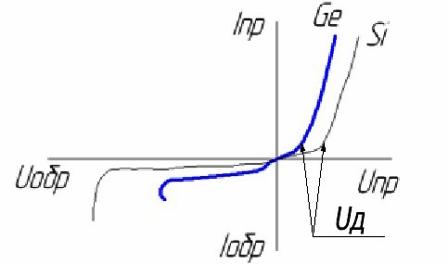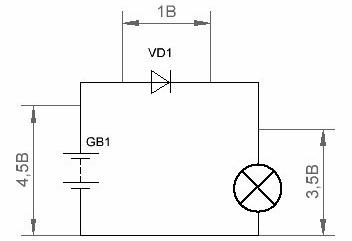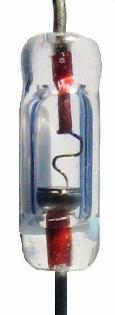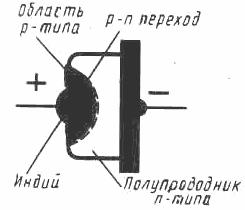Categories: Featured Articles » Novice electricians
Number of views: 175831
Comments on the article: 8
Characteristics of diodes, designs and application features
Characteristics of diodes, designs and application features
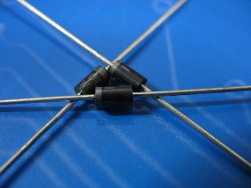 In the previous article, we started exploring semiconductor diode. In this article we will consider the properties of diodes, their advantages and disadvantages, various designs and features of application in electronic circuits.
In the previous article, we started exploring semiconductor diode. In this article we will consider the properties of diodes, their advantages and disadvantages, various designs and features of application in electronic circuits.
Current-voltage characteristic of the diode
The current-voltage characteristic (CVC) of a semiconductor diode is shown in Figure 1.
Here, in one figure, the I – V characteristics of germanium (blue) and silicon (black) diodes are shown. It is easy to notice that the characteristics are very similar. There are no numbers on the coordinate axes, since for different types of diodes they can differ significantly: a powerful diode can pass a direct current of several tens of amperes, while a low-power one can only transmit several tens or hundreds of milliamps.
There are a great many diodes of different models, and all of them can have different purposes, although their main task, the main property is one-way current conduction. It is this property that allows the use of diodes in rectifiers and detector devices. However, it should be noted that at present, germanium diodes, as well as transistors, are no longer in use.
Figure 1. Current-voltage characteristic of the diode
The direct branch of the CVC
In the first quadrant of the coordinate system, there is a straight branch of the characteristic when the diode is in direct connection - the positive terminal of the current source, respectively the negative terminal to the cathode, is connected to the anode.
As the forward voltage Upr increases, the forward current Ipr also begins to increase. But while this increase is insignificant, the graph line has a slight rise, the voltage grows much faster than the current. In other words, despite the fact that the diode is turned on in the forward direction, no current flows through it, the diode is practically locked.
When a certain voltage level is reached, a kink appears on the characteristic: the voltage practically does not change, and the current is rapidly growing. This voltage is called direct voltage drop across the diode, on the characteristic is designated as Uд. For most modern diodes, this voltage is in the range of 0.5 ... 1V.
The figure shows that the direct voltage for a germanium diode is slightly less (0.3 ... 0.4 V) than for a silicon (0.7 ... 1.1 V). If the direct current through the diode is multiplied by the forward voltage, then the result will be nothing more than the power dissipated by the diode Pd = Ud * I.
If this power is exceeded relatively acceptable, then overheating and destruction of the p-n junction can occur. That is why the reference is limited to maximum forward currentand not power (it is believed that the forward voltage is known). To remove excess heat, powerful diodes are installed on heat sinks - radiators.
Power dissipated by diode
The foregoing is explained in Figure 2, which shows the inclusion of a load, in this case a light bulb, through a diode.
Figure 2. Switching on the load through the diode
Imagine that the rated voltage of a battery and a bulb is 4.5V. With this inclusion, 1V drops on the diode, then only 3.5V will reach the bulb. Of course, no one will practically collect such a circuit, this is just to illustrate how and what the direct voltage on the diode affects.
Assume that the bulb has limited the current in the circuit to exactly 1A. This is for ease of calculation. Also, we will not take into account the fact that the bulb is an element non-linear, and does not obey Ohm's law (the resistance of the spiral depends on temperature).
It is easy to calculate that at such voltages and currents the diode dissipates power P = Ud * I or 1V * 1A = 1W.At the same time, the load power is only 3.5V * 1A = 3.5W. It turns out that more than 28 percent of the energy is consumed uselessly, more than a quarter.
If the direct current through the diode is 10 ... 20A, then up to 20W of power will be useless! It has such power small soldering iron. In the described case, the diode will be such a soldering iron.
Schottky Diodes
It is quite obvious that one can get rid of such losses if the direct voltage drop across the diode Ud is reduced. These diodes are called schottky diodes named after the inventor of the German physicist Walter Schottky. Instead of the p-n junction, they use the metal-semiconductor junction. These diodes have a direct voltage drop of 0.2 ... 0.4V, which significantly reduces the power released by the diode.
Perhaps the only drawback of Schottky diodes is the low reverse voltage - only a few tens of volts. The maximum value of the reverse voltage of 250V has an industrial design MBR40250 and its analogues. Almost all power supplies of modern electronic equipment have rectifiers on Schottky diodes.
The reverse branch of the CVC
One of the drawbacks should be considered that even when the diode is turned on in the opposite direction, the reverse current flows through it anyway, because there are no ideal insulators in nature. Depending on the model of the diode, it can vary from nanoamps to units of microamps.
Together with the reverse current, a certain amount of power is allocated to the diode, numerically equal to the product of the reverse current and the reverse voltage. If this power is exceeded, then a breakdown of the p-n junction is possible, the diode turns into a conventional resistor or even a conductor. On the reverse branch of the I – V characteristic, this point corresponds to the bend of the characteristic down.
Typically, directories do not indicate power, but some maximum permissible reverse voltage. Approximately the same as the forward current limitation, which was mentioned just above.
Actually often it is these two parameters, namely the direct current and reverse voltage, that are the determining factors when choosing a particular diode. This is the case when the diode is designed to operate at a low frequency, for example, a voltage rectifier with a frequency of an industrial network of 50 ... 60 Hz.
Electrical capacitance pn junction
When using diodes in high-frequency circuits, it is necessary to remember that the pn junction, like a capacitor, has an electric capacitance, which also depends on the voltage applied to the pn junction. This property of the p-n junction is used in special diodes - varicaps used to adjust the oscillatory circuits in the receivers. This is probably the only case when this capacity is used for good.
In other cases, this capacitance has an interfering effect, slows down the switching of the diode, and reduces its speed. This capacity is often called parasitic. It is shown in Figure 3.

Figure 3. Spurious capacitance
The design of the diodes.
Flat and Point Diodes
To get rid of the harmful effects of stray capacitance, special high-frequency diodes, for example point ones, are used. The design of such a diode is shown in Figure 25.
Figure 4. Point diode
A feature of a point diode is the design of its electrodes, one of which is a metal needle. During the manufacturing process, this needle containing an impurity (donor or acceptor) is melted into a semiconductor crystal, resulting in a pn junction of the required conductivity. Such a transition has a small area, and, therefore, a small stray capacitance. Due to this, the working frequency of point diodes reaches several hundred megahertz.
If a sharper needle is used, obtained without electro-molding, the operating frequency can reach several tens of gigahertz. True, the reverse voltage of such diodes is not more than 3 ... 5V, and the forward current is limited to a few milliamps.But after all, these diodes are not rectifier, for these purposes, as a rule, planar diodes are used. The device of a planar diode is shown in the figure.
Figure 5. Planar diode
It is easy to see that such a diode has a pn junction area that is much larger than a point one. For powerful diodes, this area can reach up to 100 or more square millimeters, so their direct current is much larger than that of point ones. It is planar diodes that are used in rectifiers operating at low frequencies, as a rule, not more than several tens of kilohertz.
Application of diodes
You should not think that diodes are used only as rectifier and detector devices. In addition, there are many more of their professions. I – V characteristic of diodes allows using them where nonlinear processing is required analog signals.
These are frequency converters, logarithmic amplifiers, detectors and other devices. Diodes in such devices are used either directly as a converter, or form the characteristics of the device, being included in the feedback circuit.
Diodes are widely used in stabilized power suppliesas sources of reference voltage (zener diodes), or as switching elements of the storage inductor (switching voltage regulators).
Using diodes, it is very simple to create signal limiters: two diodes connected in the opposite direction serve as excellent protection for the input of an amplifier, for example, a microphone, from supplying an increased signal level.
In addition to the listed devices, diodes are very often used in signal switches, as well as in logical devices. It is enough to recall the logical operations AND, OR and their combinations.
One of the varieties of diodes are LEDs. Once they were used only as indicators in various devices. Now they are everywhere and everywhere from the simplest flashlights to TVs with LED - backlight, it is simply impossible not to notice them.
Boris Aladyshkin
See also at bgv.electricianexp.com
:

